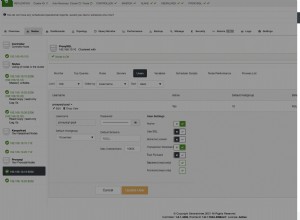A estrutura agg agora tem
$map e $reduce e $range embutido para que o processamento de matriz seja muito mais direto. Abaixo está um exemplo de cálculo de média móvel em um conjunto de dados onde você deseja filtrar por algum predicado. A configuração básica é que cada documento contém critérios filtráveis e um valor, por exemplo, {sym: "A", d: ISODate("2018-01-01"), val: 10}
{sym: "A", d: ISODate("2018-01-02"), val: 30}
Aqui está:
// This controls the number of observations in the moving average:
days = 4;
c=db.foo.aggregate([
// Filter down to what you want. This can be anything or nothing at all.
{$match: {"sym": "S1"}}
// Ensure dates are going earliest to latest:
,{$sort: {d:1}}
// Turn docs into a single doc with a big vector of observations, e.g.
// {sym: "A", d: d1, val: 10}
// {sym: "A", d: d2, val: 11}
// {sym: "A", d: d3, val: 13}
// becomes
// {_id: "A", prx: [ {v:10,d:d1}, {v:11,d:d2}, {v:13,d:d3} ] }
//
// This will set us up to take advantage of array processing functions!
,{$group: {_id: "$sym", prx: {$push: {v:"$val",d:"$date"}} }}
// Nice additional info. Note use of dot notation on array to get
// just scalar date at elem 0, not the object {v:val,d:date}:
,{$addFields: {numDays: days, startDate: {$arrayElemAt: [ "$prx.d", 0 ]}} }
// The Juice! Assume we have a variable "days" which is the desired number
// of days of moving average.
// The complex expression below does this in python pseudocode:
//
// for z in range(0, size of value vector - # of days in moving avg):
// seg = vector[n:n+days]
// values = seg.v
// dates = seg.d
// for v in seg:
// tot += v
// avg = tot/len(seg)
//
// Note that it is possible to overrun the segment at the end of the "walk"
// along the vector, i.e. not enough date-values. So we only run the
// vector to (len(vector) - (days-1).
// Also, for extra info, we also add the number of days *actually* used in the
// calculation AND the as-of date which is the tail date of the segment!
//
// Again we take advantage of dot notation to turn the vector of
// object {v:val, d:date} into two vectors of simple scalars [v1,v2,...]
// and [d1,d2,...] with $prx.v and $prx.d
//
,{$addFields: {"prx": {$map: {
input: {$range:[0,{$subtract:[{$size:"$prx"}, (days-1)]}]} ,
as: "z",
in: {
avg: {$avg: {$slice: [ "$prx.v", "$$z", days ] } },
d: {$arrayElemAt: [ "$prx.d", {$add: ["$$z", (days-1)] } ]}
}
}}
}}
]);
Isso pode produzir a seguinte saída:
{
"_id" : "S1",
"prx" : [
{
"avg" : 11.738793632512115,
"d" : ISODate("2018-09-05T16:10:30.259Z")
},
{
"avg" : 12.420766702631376,
"d" : ISODate("2018-09-06T16:10:30.259Z")
},
...
],
"numDays" : 4,
"startDate" : ISODate("2018-09-02T16:10:30.259Z")
}




